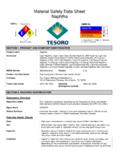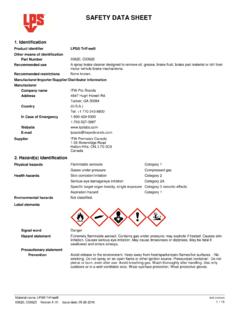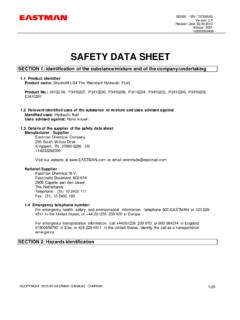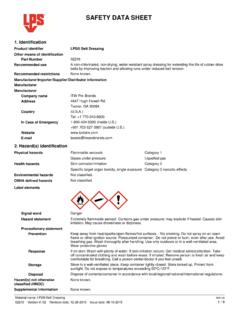Transcription of MSDS Material Safety Data Sheet - Home - IES
1 PRODUCT AND COMPANY IDENTIFICATION1 Manufacturer:The Blaster Chemical Companies, Inc. 8500 Sweet Valley Drive Valley View, Ohio 44125 (216) 901-5800 (216) 901-5801 fax 24 Hour emergency contact:Chemtrec (800) 424-9300 LG - White Lithium Grease01/22/09LG - aerosol16-LGProduct Name:Revision Date: msds Number:Product Code:COMPOSITION/INFORMATION ON INGREDIENTS2 Ingredients CAS # Percent Exposure Limits Liquefied Petroleum Gas 68476-86-8 1 5-25 % OSHA (PEL) 1000 ppm ACGIH TLV 1000 ppm Mineral Oil 64742-52 25-30 % OSHA TVL Oil Mist 5mg/m3 Lithium Thickener 4485-12-5 0-3% OSHA TVL Oil Mist 5mg/m3 Light Distillate 64742-47-8 15-20% Recomeded TWA 100 ppm Heptane 142-82-5 20-25% ACGIH (TWA)
2 400 ppm OSHA (PEL) 500 ppm Zinc Oxide 1314-13-2 0-4% Not Available LG - White Lithium GreaseMaterial Safety data Sheet Revision Date: 01/22/09 msds Number: LG - aerosolPageof16 MSDSThe Blaster CorporationHAZARDS IDENTIFICATION3 Eyes, skin, inhalation, ingestionRoute of Entry:Overexposure to this Material (or its components) has been suggested as a causeof the following effects in laboratory animals:, mild, reversible kidney effects, effects onhearing, central nervous system damageTarget Organs:Inhalation of vapors or spray mist may cause headaches, and/or nose and throat :Repeated or prolonged contact with skin may produce redness, irritation and/or dryness.
3 Maycause or aggravate dermatitis or other existing skin Contact:May cause immediate or delayed irritation. Irritation may show up as redness and/or swelling. Maycause corneal Contact:Ingestion may cause irritation to the mouth, esophagus, and/or :Signs or Overexposure: Irritation of eyes, nose, throat, digestive tract. Pre-existing Conditions Aggravated: Skin and respiratory disorders. Alcoholism, kidney, liver, cardiovascular and nervous systemCAUTION! CONTENTS UNDER PRESSURE EXTREMELY FLAMMABLE Odor/Appearance: White to brownish spray as dispensed from aerosol AID MEASURES4 Remove to fresh air.
4 If not breathing, give artificial respiration. If breathing is difficult, give to monitor. Get medical :Remove contaminated clothing immediately! Wash skin with soap and water. If irritation develops,seek medical Contact:Flush eye(s) with water for 15 minutes. Get medical attention. If eye irritation persists, obtainmedical Contact:Immediately give the person two large glasses of water. Do not induce vomiting. Get medicalattention immediately. DO NOT GIVE AN UNCONCIOUS OR CONVULSING PERSONANYTHING BY MOUTH!Ingestion:LG - White Lithium GreaseMaterial Safety data Sheet Revision Date: 01/22/09 msds Number: LG - aerosolPageof26 MSDSThe Blaster CorporationFIRE FIGHTING MEASURES5 Flash point:<0oF* Extinguishing Media: Dry chemical, carbon dioxide or foam is recommended.
5 Water spray may be used to cool containers or structures. General Fire and Explosion Hazards: This Material may be ignited by heat, sparks (static electricity), flame or other ignition sources. Vapors are heavier than air and will collect in low areas (sewers) and can travel considerable distances. If containers are not cooled in a fire, they may explode. Fire Fighting Procedures: Emergency responders should wear self-contained breathing apparatus. Wear other protective gear as conditions warrant. Keep unauthorized people out. Try to contain spills or leaks if it can be done safely. Material will float on water. Avoid spreading. Unusual Fire & Explosion Hazard: Level 3 Aerosols - Contents Under Pressure Special Fire Fighting Procedures: At elevated temperatures (over 130F) aerosol container may burst, vent or rupture; use equipment or shielding to protect personnel.
6 Cooling exposed containers with streams of water may be helpful. Emergency responders should wear self-contained breathing apparatus. Wear other protective gear as conditions warrant. Keep unauthorized people out and try to contain spills or leaks if it can be done safely. Material will float on water, avoid spreading the LEL/UEL of this product have not been RELEASE MEASURES6 Leaking aerosol cans should be put into suitable container until the internal pressure has dissipated. Use suitable absorbents to collect liquid product. Consult regulations for the disposal of the container, liquid and absorbents. HANDLING AND STORAGE7Do not puncture or burst. Use in accordance with good work place practices.
7 Use withadequate ventilation. Keep containers closed when not in use. Always open containersslowly to allow any excess pressure to vent. Avoid breathing vapor. Avoid contact witheyes, skin or clothing. Wash thoroughly with soap and water after handling. Decontaminatesoiled clothing thoroughly before re-use. Destroy contaminated leather clothing. Emptycontainers may contain residues from the product. Treat empty containers with the sameprecautions as the Material last contained. Do not cut, weld or apply heat to emptycontainers Do not incinerateHandling Precautions:Store in a dry place away from excessive heat. Store containers with lids on and not store at temperatures above 120 degrees Requirements:LG - White Lithium GreaseMaterial Safety data Sheet Revision Date: 01/22/09 msds Number: LG - aerosolPageof36 MSDSThe Blaster CorporationEXPOSURE CONTROLS/PERSONAL PROTECTION8 Eye wash stations and emergency showers should be immediately Controls:Eyes and Face: Standard Safety glasses with splash shields typically offer adequateprotection.
8 Where excessive splashing or spraying is possible, a face shield should and clothing: Excessive contact should be avoided. Nitrile gloves, boots andaprons will provide adequate protection when contact cannot be avoided. Remove andwash any contaminated clothing immediately. Wash thoroughly after : Good general ventilation should be sufficient to control airborne airborne concentrations below OSHA established exposure limits ofingredients in Section Equipment:The Blaster Chemical Companies takes no responsibility for determining what measures are required for personal protection in any specific application. This information should be used with discretion. Exposure Guidelines/Other:PHYSICAL AND CHEMICAL PROPERTIES9white cream colored greaseAppearance:aerosolPhysical State:typical petroleumOdor:not determinedpH:not determinedVapor Pressure:>1 (air = 1)Vapor Density:not determinedBoiling Point:not determinedFreezing/Melting Pt.
9 :EmulsifiesSolubility:<1 (water = 1)Spec :not determinednot determined<1 (ether = 1)not determinednot determinednot determinednot applicablenot applicablenot determinednot determinednot determinednot determinedHeat Value:VOC:Evap. Rate:Bulk Density:Octanol:Molecular Weight:Particle Size:Softening Point:Viscosity:Percent Volatile:Sat. Vap. Concentrat.:Molecular Formula:LG - White Lithium GreaseMaterial Safety data Sheet Revision Date: 01/22/09 msds Number: LG - aerosolPageof46 MSDSThe Blaster CorporationSTABILITY AND REACTIVITY10 This product is :Avoid excessive heat, sources of ingition and excessive to avoid:Avoid strong oxidizersMaterials to avoid (incompatability):Carbon monoxide, carbon dioxide and various hydrocarbonsHazardous Decomposition products:Will not Polymerization:TOXICOLOGICAL INFORMATION11 Acute oral toxicity n-HEPTANE LD 50 Rat: > 15,000 mg/kg Light Distillate LD50 Rat > 5,000 mg/kg Acute inhalation toxicity n-HEPTANE LC 50 Rat.
10 103 g/m3 , 4 h Light Distillate LC 50 > mg/l Acute dermal toxicity n-HEPTANE LD 50 Rabbit: > 2,001 mg/kg Light Distillate LD 50 Rabbit 2,000 - 4,000 mg/kgECOLOGICAL INFORMATION12 Ecological information on this product as a mixture has not been determined. DISPOSAL CONSIDERATIONS13 Used or unused product should be disposed of in accordance with local, state and federal regulations. Some specialregulations may exist for the disposal of aerosol containers may contain residual pressure and contents. They should be handled with the same precautions as INFORMATION14 Dept. of Transportation (DOT): This product, as it leaves Blaster's facilities, meets the definitions set forth in CFR 49 part as a "consumer commodity.






